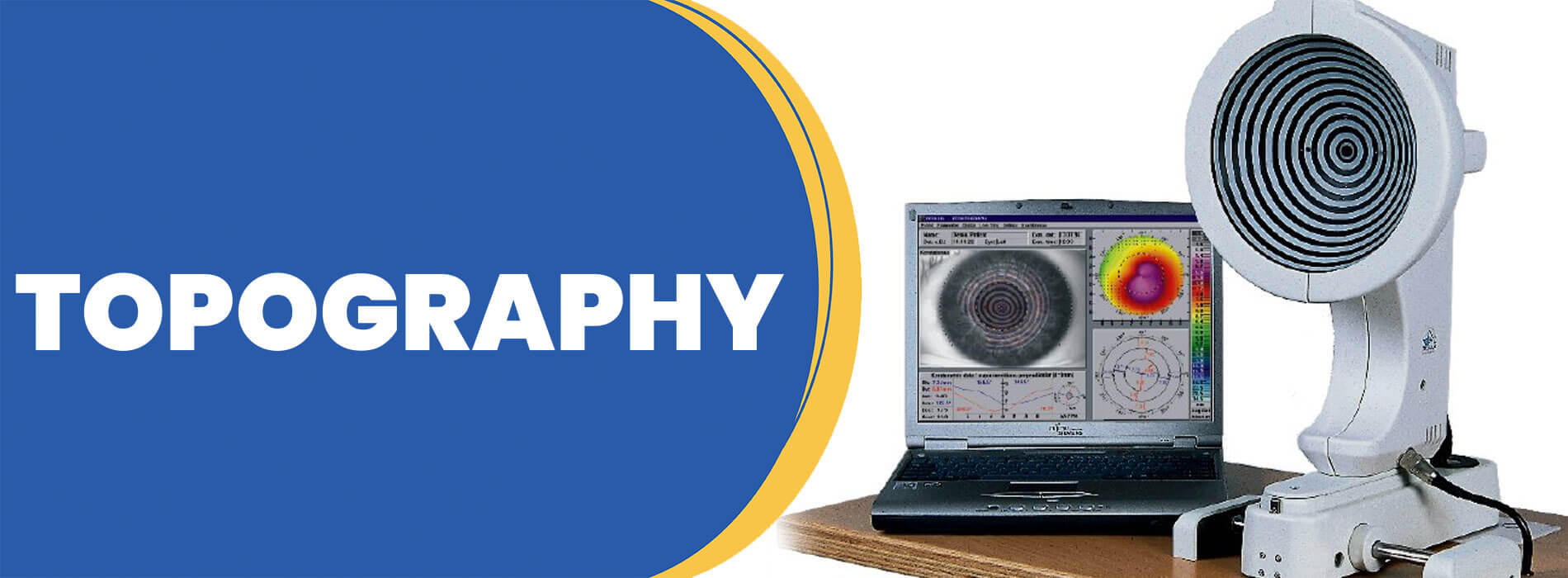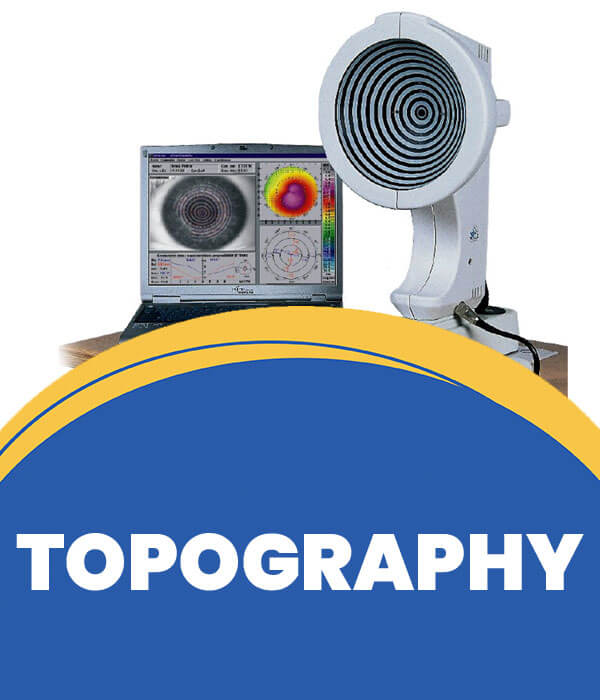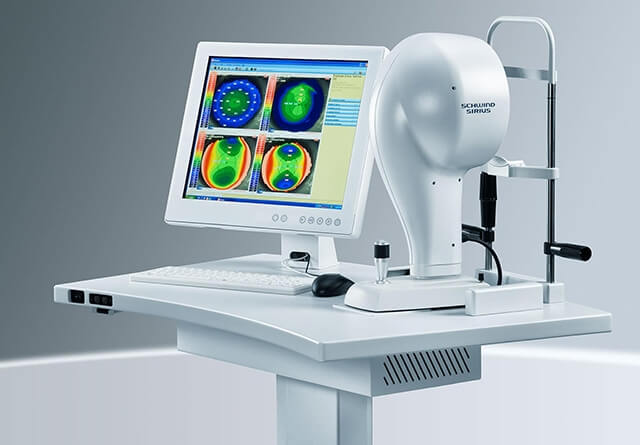

Ultra Modern Advanced Corneal Topography
Best Advanced Corneal Topography Treatment
Corneal topography is an advanced, computer-assisted diagnostic technique used to create a precise, three-dimensional map of the cornea’s surface curvature. The cornea, which is the eye’s clear, dome-shaped outer surface, is responsible for about 70% of the eye’s focusing power. Because of its critical role in vision, the health and shape of the cornea are essential for optimal eyesight.
In a healthy eye, the cornea is uniformly curved. However, if the cornea is too flat, too steep, or exhibits uneven curvature, it can lead to visual disturbances and impairments. Corneal topography helps to detect these subtle irregularities, which may not be visible through standard eye exams. This makes corneal topography a powerful tool in diagnosing a range of eye conditions, ensuring a higher degree of accuracy and treatment planning.
We are renowned for providing the best advanced corneal topography treatments in Andheri, Mumbai India. Our clinic is equipped with state-of-the-art topography equipment that guarantees precise, detailed mappings of the cornea, empowering our specialists to provide the most effective treatments for your eye health.

Purpose and Applications of Corneal Topography
Corneal topography is more than just a diagnostic tool—it’s a vital procedure for mapping the curvature and surface characteristics of the cornea. The key applications of this technology include:
- Diagnosis of Corneal Conditions: It helps in the early detection of corneal irregularities such as keratoconus, astigmatism, and pterygium.
- Preoperative Assessment for Refractive Surgery: For those considering LASIK, SMILE, or PRK, corneal topography is essential for planning the most effective laser eye surgery.
- Contact Lens Fitting: Corneal topography provides detailed information for designing customized contact lenses, especially for patients with irregular corneas or those requiring scleral lenses.
- Monitoring Postoperative Changes: It’s invaluable for tracking the progress of corneal healing after surgery, ensuring optimal outcomes and detecting any complications early.
At Ashu Laser Vision, our highly skilled team uses advanced corneal topography technology to provide the most accurate assessments and tailor personalized treatment plans for each patient. This ensures the best possible results for conditions ranging from keratoconus to astigmatism.
Advanced Technology for Corneal Topography
We use the latest corneal topography equipment such as the OCT topography system, which combines high-resolution optical coherence tomography (OCT) and corneal mapping to offer highly detailed, 3D images of the cornea. This is particularly useful for mapping the shape of the cornea before laser vision correction surgeries like LASIK and SMILE, ensuring accurate planning and minimal risk.
In our Andheri clinic, we utilize the latest corneal topography systems to ensure that our patients receive the most precise, state-of-the-art assessments. This advanced technology allows us to accurately measure and track the corneal curvature, identify abnormal patterns, and plan treatments with unparalleled precision.
Why Choose Ashu Laser Vision for Corneal Topography
- State-of-the-Art Equipment: We invest in the latest corneal topography and OCT topography technologies to provide the most accurate diagnostics.
- Expert Ophthalmologists: Our team of experienced ophthalmologists and optometrists in Andheri specialize in the interpretation of corneal maps, ensuring you receive the most effective treatment plans.
- Customized Treatment Plans: Using detailed corneal topography data, we create personalized treatment plans tailored to your unique corneal condition.
- Comprehensive Eye Care: Beyond corneal topography, our clinic offers a full range of laser eye treatments, cataract surgeries, glaucoma management, and retinal care.
- Patient-Centered Approach: We focus on patient comfort and provide clear, detailed explanations of each procedure, ensuring you feel informed and confident in your treatment options.
Common Eye Conditions Diagnosed with Corneal Topography
- Keratoconus: A condition where the cornea becomes thin and bulges into a cone shape, causing distorted vision. Corneal topography is the gold standard for detecting keratoconus in its early stages.
- Astigmatism: Irregularities in the shape of the cornea or lens lead to astigmatism, which can cause blurry or distorted vision. Topography helps to map out the exact nature and extent of this condition.
- Corneal Ectasia: A post-surgical complication, often after LASIK or PRK, that causes the cornea to thin and bulge.
- Pterygium: Growth of tissue over the cornea, commonly in the inner corner of the eye.
- Post-Surgical Monitoring: After laser vision correction surgery, corneal topography helps track the corneal healing process, ensuring the results are as expected.
Book Your Corneal Topography Appointment
If you’re looking for advanced corneal topography services in Andheri, Mumbai, schedule an appointment with our expert team at Ashu Laser Vision and Ashu Eye Hospital today. Whether you need a preoperative assessment for LASIK or a detailed diagnosis for conditions like keratoconus, we are here to help you achieve the best outcomes for your eye health.
Our commitment to combining the latest corneal topography technology with years of expertise ensures you receive the highest standard of care. Take the first step towards optimal vision today—contact us for an appointment at Ashu Laser Vision and Ashu Eye Hospital, the best corneal topography clinic in Andheri, Mumbai.
Advanced Corneal Topography Treatment
What Makes Corneal Topography Essential in Modern Ophthalmology?
Corneal topography has revolutionized the way ophthalmologists diagnose and treat eye conditions. By generating detailed, three-dimensional corneal maps, this technique offers unparalleled insights into the curvature, elevation, and surface shape of the cornea. These detailed maps are essential not only for vision correction surgeries but also for diagnosing a range of corneal abnormalities that were previously hard to detect through traditional methods.
The role of corneal topography extends beyond simple diagnostic procedures; it is integral to optimizing patient outcomes in complex refractive surgeries, offering a level of precision and accuracy that traditional eye tests cannot match. At Ashu Laser Vision and Ashu Eye Hospital, we leverage cutting-edge technologies and advanced corneal topography systems to provide patients with the highest quality of eye care in Andheri, Mumbai.
How Does Advanced Corneal Topography Improve Treatment Outcomes?
Advanced corneal topography goes beyond basic mapping by offering comprehensive data that is used in both preoperative and postoperative assessments. By mapping the entire surface of the cornea, topography provides key metrics for doctors to determine the exact laser settings required during surgeries like LASIK, SMILE, and PRK.
Here are some of the reasons why advanced corneal topography is critical for improving treatment outcomes:
- Highly Detailed 3D Mapping: Traditional methods only assess the central cornea, but modern corneal topography provides an accurate map of the entire corneal surface, including the peripheral regions. This allows surgeons to tailor their interventions to the unique shape and curvature of each patient’s cornea.
- Enhanced Precision in LASIK & SMILE: For surgeries like LASIK and SMILE, the success rate is heavily dependent on the precise mapping of the corneal curvature. With advanced corneal topography, doctors can fine-tune the laser settings, ensuring that the amount of tissue removed is exactly right for optimal visual outcomes.
- Early Detection of Corneal Diseases: Keratoconus, corneal ectasia, and irregular astigmatism can now be diagnosed at much earlier stages with topography. Early detection of these conditions is essential for effective treatment before they lead to significant vision impairment.
- Postoperative Monitoring and Adjustment: After laser procedures, corneal topography enables doctors to track the healing process and make necessary adjustments to prevent complications, such as under- or over-correction.
The Latest Technologies in Corneal Topography for Comprehensive Diagnosis
At Ashu Laser Vision, we use the latest corneal topography technologies, including:
- Topographic Imaging with OCT Integration: Optical Coherence Tomography (OCT) integrated with corneal topography provides high-resolution imaging that visualizes both the front and back surfaces of the cornea. This combination offers a detailed map that can predict how the cornea will respond to refractive surgery.
- Wavefront-Guided Topography: This next-level technology allows us to capture the unique wavefront signature of your eye, identifying irregularities in how light travels through your eye. By incorporating wavefront-guided topography, we can precisely target laser corrections to improve visual acuity in ways that traditional methods cannot achieve.
- Dynamic Corneal Topography: This advanced dynamic analysis measures the changes in corneal curvature during the blink or eye movements, providing a real-time understanding of how your cornea behaves under various conditions, which is especially useful for fitting customized contact lenses.
Applications of Corneal Topography Beyond Refractive Surgery
While corneal topography is primarily used in refractive surgeries such as LASIK and SMILE, its uses extend far beyond that. Here’s how advanced corneal topography contributes to the overall management of eye health:
- Monitoring Keratoconus: One of the most important uses of corneal topography is for the early detection and monitoring of keratoconus—a progressive disease where the cornea becomes thin and cone-shaped. Topography maps the cornea’s surface to track disease progression, allowing for timely intervention to slow its development.
- Management of Post-Surgical Complications: After any eye surgery, corneal topography is essential for ensuring the cornea heals correctly. Whether you’ve had LASIK, PRK, or cataract surgery, topography will track any potential complications like corneal scarring or irregular healing, ensuring that you can receive immediate treatment if necessary.
- Customized Contact Lenses: For individuals with irregular corneas or those suffering from conditions like astigmatism, corneal topography is critical in designing customized contact lenses, such as scleral lenses, that perfectly fit the curvature of the eye.
Why Ashu Laser Vision is the Leading Provider of Corneal Topography
- Precision Diagnostics: At Ashu Laser Vision, we utilize state-of-the-art corneal topography technologies to offer the most precise diagnostics, ensuring that every treatment plan is tailored to your unique corneal characteristics.
- Expert Ophthalmologists: With over 16 years of experience, Dr. Shahnawaz Kazi and his team of specialists in Andheri, Mumbai are highly skilled in interpreting corneal topography data and using it to plan and execute vision correction surgeries with the highest accuracy.
- Personalized Care: Every patient’s eye health is different. Using advanced corneal topography, we provide personalized consultations and treatment plans that are specifically suited to your needs, ensuring optimal vision outcomes.
- Holistic Eye Care: Beyond just corneal mapping, our clinic offers a range of treatments including laser vision correction, cataract surgery, and glaucoma management. We take a comprehensive approach to your eye health, addressing all aspects of your ocular needs.
With over 16 years of experience in advanced corneal topography and ocular health management, Dr. Shahnawaz Kazi has successfully treated a wide range of patients, including those with Diabetic Retinopathy, achieving outstanding results. His deep expertise in corneal mapping and the latest diagnostic technologies has played a pivotal role in providing personalized care for Diabetic Retinopathy patients, helping them manage and even reverse the effects of this debilitating condition.
By integrating cutting-edge topography technology with a comprehensive understanding of retinal diseases, Dr. Kazi ensures each patient receives a tailored treatment plan that addresses their specific needs. His success rate in treating Diabetic Retinopathy and other retinal conditions highlights his commitment to delivering high-quality, patient-centered care. At Ashu Laser Vision, we continue to provide world-class eye care, empowering patients to maintain their vision and improve their quality of life.
Book Your Appointment for Corneal Topography
If you’re looking for advanced corneal topography treatment in Andheri, Mumbai, Ashu Laser Vision is here to provide you with the most accurate and reliable eye care services. From refractive surgery consultations to early keratoconus diagnosis, our clinic is equipped with the latest topography technology to ensure you receive the best possible care.
Contact us today to schedule your appointment with one of our expert ophthalmologists and take the first step toward clearer, healthier vision.
FAQs about Corneal Topography and Advanced Corneal Topography
Corneal topography is a diagnostic technique that uses advanced imaging technology to map the curvature and shape of the cornea, the clear, dome-shaped surface at the front of the eye. It helps identify irregularities in the corneal surface, which can affect vision and aid in planning treatments like LASIK and SMILE.
Corneal topography is essential because it provides detailed, 3D maps of the cornea. This information helps ophthalmologists detect early signs of corneal diseases like keratoconus, plan refractive surgeries like LASIK, and fit customized contact lenses for patients with irregular corneas.
Corneal topography works by projecting light onto the cornea’s surface and analyzing the reflections. This creates a detailed map of the cornea’s curvature, showing any irregularities in its shape. The data collected is then displayed in a color-coded map for easy interpretation by the doctor.
- Keratoconus
- Astigmatism
- Corneal ectasia (post-surgery)
- Pterygium
- Irregular corneas
- Postoperative corneal changes from refractive surgery
No, corneal topography is a specialized diagnostic tool that focuses specifically on the shape and curvature of the cornea, whereas a regular eye exam evaluates overall eye health and vision clarity, including refraction and pressure testing.
A corneal topography test typically takes about 10 to 15 minutes. It is a non-invasive, painless procedure, and there is no recovery time required afterward.
Generally, no special preparation is needed for corneal topography. However, it’s advisable to avoid wearing contact lenses for a few hours prior to the test, as they may distort the natural shape of your cornea.
Yes, corneal topography is highly effective at detecting keratoconus, a condition where the cornea becomes thin and bulges outwards. Early detection through topography can help in timely intervention and treatment.
Absolutely. Corneal topography is a critical tool in LASIK planning. It helps determine the cornea’s shape and thickness, ensuring the cornea is healthy enough for surgery and allowing the surgeon to tailor the laser settings for optimal results.
Corneal topography maps the curvature and shape of the cornea, whereas Optical Coherence Tomography (OCT) captures high-resolution images of both the front and back surfaces of the cornea, as well as the retina. OCT is often used in combination with topography for a comprehensive analysis.
Yes, corneal topography is essential for customized contact lenses fitting, especially for patients with irregular corneas or conditions like astigmatism. It helps in designing scleral lenses and other specialized lenses for better comfort and vision.
Corneal topography identifies the exact pattern of astigmatism by mapping out the corneal curvature. It helps the doctor assess whether the astigmatism is due to irregularities in the cornea or other factors, enabling them to provide targeted treatment.
Yes, corneal topography is highly sensitive and can detect early signs of eye diseases like keratoconus and corneal ectasia before symptoms are noticeable. Early detection is key to preventing further damage and managing these conditions effectively.
Yes, corneal topography is a safe, non-invasive, and painless procedure. It does not involve any contact with the eye, and there are no known risks or side effects associated with the test.
Yes, corneal topography is essential for determining whether a patient is a suitable candidate for LASIK. It helps assess the thickness and shape of the cornea, which are critical factors in the success of the procedure. It also helps in customizing the laser treatment for optimal results.
Advanced corneal topography provides more detailed, accurate, and high-resolution data compared to traditional methods. It helps in:
- Customized treatment planning
- Early diagnosis of corneal diseases
- Monitoring postoperative changes
- Enhanced precision in refractive surgery and contact lens fitting
Dynamic corneal topography captures real-time data about the cornea’s behavior during eye movements or blinks. This helps in understanding the cornea’s functionality, which is particularly useful for patients wearing specialized contact lenses.
Yes, corneal topography is essential for post-LASIK monitoring. It tracks the healing process and identifies any complications such as corneal irregularities or scarring, allowing for timely intervention if necessary.
Yes, corneal topography is a key component in planning all types of refractive surgeries like LASIK, SMILE, PRK, and LASEK. It helps determine the amount of corneal tissue to be removed and ensures optimal visual outcomes.
Corneal topography is extremely accurate and provides highly detailed, 3D images of the cornea. The technology allows ophthalmologists to assess corneal health with great precision, making it a crucial tool in diagnosing corneal diseases, planning surgeries, and fitting contact lenses.

